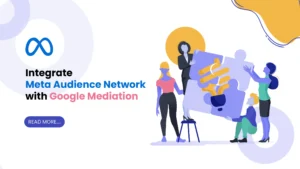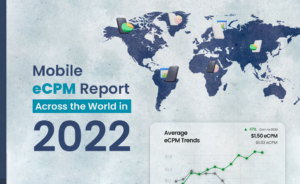Programmatic Ad Mediation by AdPumb for High App Revenue

The mobile app market is thriving! The worldwide mobile application market is estimated to be worth USD 206.85 billion in 2022 and USD 228.98 billion in 2023. One of the primary reasons for such development is the in-app spending made by advertising in applications.
As marketers saw the value of in-app traffic, they shifted marketing resources away from the web and into in-app ad campaigns. Ad mediation has established a reputation as a comprehensive app monetization solution that aids developers in generating scalable revenue from their mobile apps.
Here, we’ll get into the process of programmatic ad mediation, explaining how it works, what to keep in mind as you go through the process, and going over its primary benefits.
What is Ad Mediation?
Ad mediation begins with a problem: There are several ad networks, each with thousands of ads. Installing and administering several networks, on the contrary, might be complex. Installing a single network is the obvious, low-stress solution. Yet, doing so might result in a significant loss of revenue. The good news is that dozens of ad networks may be accessed using a single mediation software development kit (SDK).
What is the process of Ad Mediation? (Steps Involved)
Step I. The ad mediation platform receives an ad request.
Step II. The ad mediation platform obtains a list of ad networks capable of delivering an ad.
Step III. The ad mediation platform arranges ad networks in descending order of bid performance, from highest to lowest bid. Publishers can also organise ad networks in the order they desire.
Step IV. The mediation platform assigns the request to the first-preferred ad network. If it does not, the request is on to the next.
Step V. The selected bidder wins, and their ad gets served in the ad spot.
Types of Mobile Ad Mediation
There are two sorts of mobile ad mediations: those handled by app creators directly and those carried by ad mediators. Ad networks and ad agencies often represent the latter. So, what is the key distinction?
Ad Mediation on your own – When ad mediation falls on the shoulders of an app developer, a lot of work is required. Initially, you must identify and contact each potential demand partner one after the other. Second, you must agree on CPM rates, fill rates and payment conditions. Next, you must obtain their SDKs and include them in your app code.
Pros
- You may monetize your app even if you have a small number of DAU/MAU.
- You have complete control over the mobile ad types, spots, and frequency capping.
- You only deal with ad partners whose demand best matches your audience’s values.
- You do not share your revenues with any third-party service provider.
Cons
- A profitable Ad Mediation takes a significant investment of time and work.
- Before every new launch, you should test several ad formats, ad spots, and other ad campaign settings to determine the best-working formula for your app.
- You must deal with daily optimization to maintain a high CPMs and fill rate.
- When working with numerous demand sources, you overburden your app with SDKs.
- Your monthly revenue will get dispersed into installments that arrive at different times.
Ad mediation with AdPumb – the definitive Ad Mediation Platform
AdPumb already partners with ad agencies, DSPs, and networks. As a result, while using only one ad mediator, you may gain access to the world’s leading advertisers and mobile ad networks via a single lightweight SDK. The greater the number of ad networks in the app, the better the fill rate and income. Simultaneously, the more ad networks you have in a pool, the more difficult ad mediation will be.
Pros
- You’ll be delivered the best-matching mobile ad demand on a silver platter.
- Onboarding is quick and straightforward because you only need to integrate one lightweight SDK into your app’s code.
- You can get a near-100% fill rate with just one ad mediator.
- Ad mediation ensures high CPM prices and monthly revenue.
- Some ad mediators handle daily optimization, performance tracking, etc.
- Your monthly payment will get made in one big sum at a predetermined date.
- You save significant time and money, allowing publishers to concentrate on their work.
Reasons for Choosing Ad Mediation
- Maximum Bids with Minimum Effort – Key to unlocking higher bids for your mobile ad inventory is mediation. A platform that links to numerous networks might offer more purchasers in an auction. Furthermore, you may boost your revenue yield by collaborating with partners who provide mobile header bidding solutions to generate incremental income to your bottom line.
- More Ad Networks to Choose From – Each ad network is distinct and provides different value to publishers. With a mediation platform, you may identify networks in regions other than the United States and those that focus solely on the type of ads you want to work. Eventually, there will be networks that reward you with better fill rates while others deliver larger eCPMs. A good mediation platform will have the correct network mix.
- Reduced SDK Bloat – The finest mobile mediation platforms simplify integration by eliminating the requirement for various SDKs from different networks. For example, you may locate a platform that provides a bundler to generate one SDK for your mobile app, access each network you’ve chosen, and expand the reach of your inventory.
- Alternatives for Optimization – Mobile ad mediation solutions aid in the optimization of ad network statistics such as response time, fill rates, eCPMs, and CTRs. These parameters are then translated in real-time back to criteria like area, app kind, and device type, assisting mobile app developers in finding the most relevant and high-paying advertising for their inventory.
- Reporting in one location – The nice thing about using a mobile ad mediation platform is that you can manage all your networks in one place, which means all your revenue and performance reporting can be accessed in one location. The finest monetization specialists utilize dashboards extensively and search for patterns to maximize revenue. Publishers can keep track of their profits by using a single dashboard to check how each network is doing.
Advantages of Ad Mediation
- Increased CPM rates – When you use one ad partner to monetize your app, you restrict its possibilities. You always agree to sell your impressions for the given (and only feasible) amount here. The problem is that your advertising partner may have weak hands in your key markets. As a result, you will not be compensated fairly for your traffic.
In turn, ad mediation provides high CPM rates via integration with various demand partners. When you monetize your app with many ad networks simultaneously, you force them to fight for your inventory. As a result of the increased competition, prices climb, and the ad partner with the highest bid wins the impression.
- Increased Fill rates – Ad mediation improves ad fill rates by increasing the quantity of ad inventory sold. Publishers can grant access to their ad inventory to numerous ad networks, allowing advertisers to compete for ad space, which increases competition among marketers ready to pay more for the unit.
What else should publishers look for when opting for Ad Mediation?
Support for networks and features – When looking for the best ad mediation partner, the first thing to evaluate is which networks and regions are supported.
Furthermore, it is critical to ensure that any solution enables bidding for your most relevant ad networks. A developer may also wish to explore a mediation service that allows them to have both alternatives (Waterfall and Bidding) for the same ad network, allowing them to test and select what works best.
- User Experience – When trying to make quick judgments regarding a mediation platform, the last thing a developer wants to do is wrestle with an unruly user interface. As a result, it’s critical to assess if the solution has a clean, straightforward Interface that the team feels at ease working with.
- Reports – More is always better when it comes to data and analytics. But it’s also critical to evaluate the ad mediation platform’s degree of granularity because that’s how a team will be able to truly slice and dice their data to understand their app’s particular demands, audience, markets, and overall success.
- SDK ease of use – Lastly, evaluate the SDK of an ad mediation platform. While it is critical to have a seamless integration at first, teams should also consider what it will be like to maintain in the long run.
In conclusion
Overall, mobile ad mediation with AdPumb is the greatest way to obtain an advantage in in-app monetization. AdPumb includes everything your app needs for lucrative and long-term ad mediation. Begin your in-app monetization adventure today and get immediate results! Now is the time to subscribe to AdPumb Programmatic Mediation!





